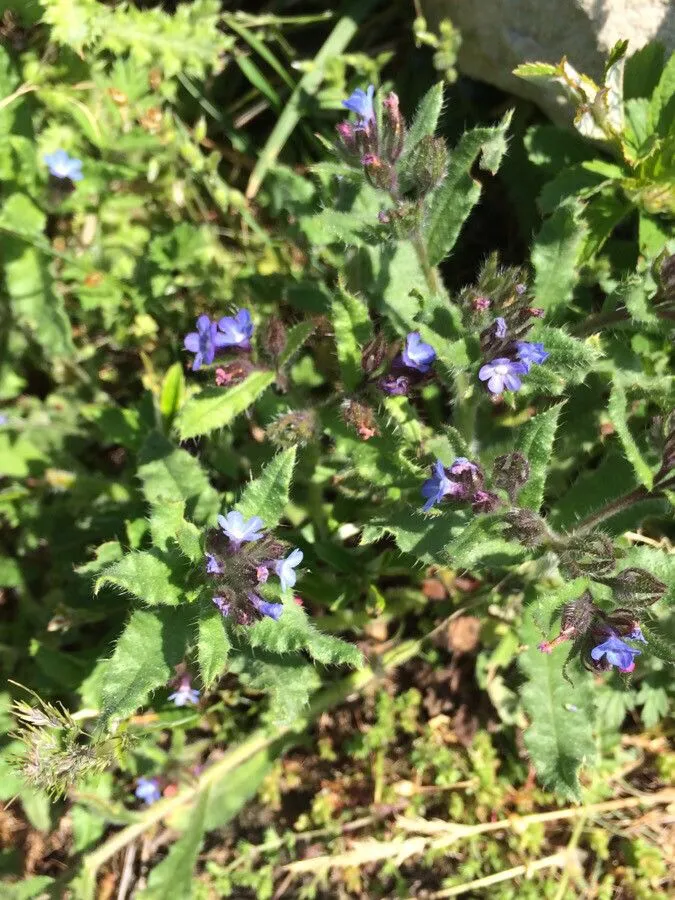
Author: (L.) M.Bieb.
Bibliography: Fl. Taur.-Caucas. 1: 123 (1808)
Year: 1808
Status: accepted
Rank: species
Genus: Anchusa
Vegetable: Unknown
Observations: Europe
Bugloss, scientifically known as Anchusa arvensis, is a noteworthy species belonging to the Boraginaceae family. Renowned for its vivid and eye-catching blue flowers, this plant has captivated botanists and gardening enthusiasts alike. Documented in the authoritative “Flora Taurico-Caucasica” (Fl. Taur.-Caucas.) by M.Bieb. in the early 19th century, specifically 1808, Bugloss has a rich history of botanical study and admiration.
Native to Europe, Anchusa arvensis thrives in a range of environments across the continent. It is commonly found in meadows, pastures, and along roadsides where it adds a splash of color to the landscape. The plant is characterized by its hairy foliage, which can sometimes cause skin irritation upon contact. Despite this, its aesthetic appeal and ecological benefits, such as attracting pollinators like bees, make it an important component of its natural habitat.
The vibrant blue flowers of Bugloss are small yet striking, typically blooming from late spring to early summer. These blooms not only enhance the scenery but also serve a critical role in the local ecosystem by supporting various pollinators.
Although Anchusa arvensis may not be as widely known as other garden staples, its resilience and low maintenance make it a valuable addition to wildflower gardens and naturalized areas. The plant’s ability to thrive in less-than-ideal soil conditions also contributes to its popularity among those looking to cultivate a more natural and sustainable garden environment.
In summary, Bugloss stands out not only for its beauty but also for its historical and ecological significance within the European landscape. Studied and classified by renowned botanist M.Bieb., this plant continues to be appreciated for its vibrant blooms and the role it plays in supporting biodiversity.
En: Bugloss, Small bugloss, Annual bugloss, Wild bugloss, European bugloss, Field Bugloss
Cs: Prhlica rolná
Da: Krumhals, Sur-Kirsebær, Weichsel
Nl: Kromhals
Fi: Hapankirsikka
Fr: Lycopside, Lycopside des champs, Buglosse des champs
De: Acker-Krummhals, Acker-Ochsenzunge, Krummhals, Gewöhnlicher Acker-Krummhals
Se: Sávzzanjuovčča
No: Kirsebær, Mahaleb
Sv: Glanshägg, Körsbärsplommon, Surkörsbär, Vejksel, Fårtunga, Rast
Cy: Bleidd-Drem, Bwglos, Llysiau’r-Gwrid y Tir Âr, Tafod yr Ych Culddail, Tafod yr Ych Meddygol
© copyright of the Board of Trustees of the Royal Botanic Gardens, Kew.
© copyright of the Board of Trustees of the Royal Botanic Gardens, Kew.
© copyright of the Board of Trustees of the Royal Botanic Gardens, Kew.
Taken Apr 13, 2020 by JenniferPe (cc-by-sa)
Taken Jul 12, 2021 by Václav Meškan (cc-by-sa)
Taken May 21, 2022 by Шамхалов Магомед (cc-by-sa)
Taken Jun 15, 2011 by Jean-Louis PASTEUR (cc-by-sa)
Taken Apr 10, 2006 by Alexander Baransky (cc-by-sa)
Taken Feb 17, 2020 by Ángel Díaz Montes (cc-by-sa)
Taken Apr 17, 2022 by Шамхалов Магомед (cc-by-sa)
Taken Jun 15, 2011 by Jean-Louis PASTEUR (cc-by-sa)
Taken Jun 20, 2022 by magda van damme (cc-by-sa)
Taken Apr 29, 2020 by Indulis Bumanis (cc-by-sa)
Taken Jun 23, 2007 by Henk Van Lottum (cc-by-sa)
Taken Jun 15, 2011 by Jean-Louis PASTEUR (cc-by-sa)
Taken May 13, 2021 by Arsham Hekmat (cc-by-sa)
Taken May 30, 2014 by Tela Botanica − Hervé Goëau (cc-by-sa)
Family: Myrtaceae Author: (F.Muell.) K.D.Hill & L.A.S.Johnson Bibliography: Telopea 6: 402 (1995) Year: 1995 Status:…
Family: Rubiaceae Author: Pierre ex A.Froehner Bibliography: Notizbl. Bot. Gart. Berlin-Dahlem 1: 237 (1897) Year:…
Family: Sapindaceae Author: Koidz. Bibliography: J. Coll. Sci. Imp. Univ. Tokyo 32(1): 38 (1911) Year:…
Family: Asteraceae Author: A.Gray Bibliography: Pacif. Railr. Rep.: 107 (1857) Year: 1857 Status: accepted Rank:…
Family: Fabaceae Author: Medik. Bibliography: Vorles. Churpfälz. Phys.-Ökon. Ges. 2: 398 (1787) Year: 1787 Status:…
Family: Aspleniaceae Author: (Cav.) Alston Bibliography: Bull. Misc. Inform. Kew 1932: 309 (1932) Year: 1932…